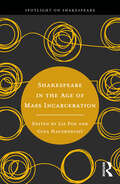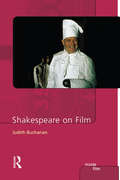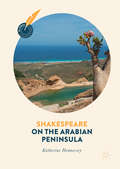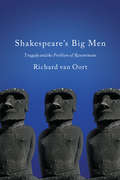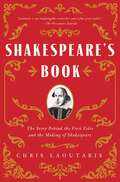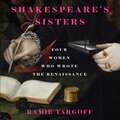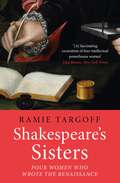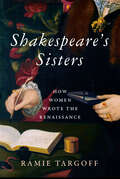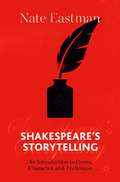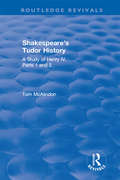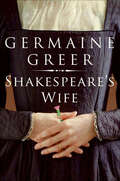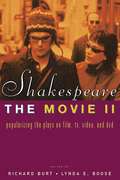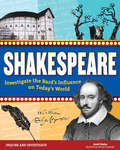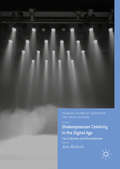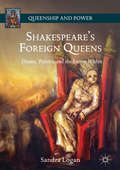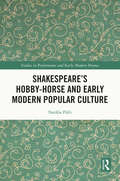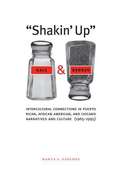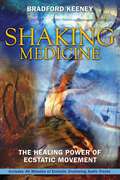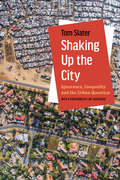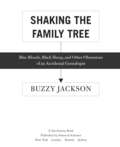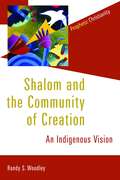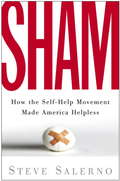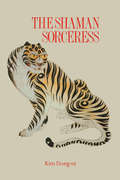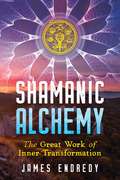- Table View
- List View
Shakespeare in the Age of Mass Incarceration (Spotlight on Shakespeare)
by Liz Fox and Gina HausknechtShakespeare in the Age of Mass Incarceration offers invaluable insight into how Shakespeare appears in prison. Bringing together theater artists, currently and formerly incarcerated actors, and college-in-prison educators and students, the collection describes powerful encounters in classrooms and rehearsal rooms as they explore the complexity of “prison Shakespeare.”In this innovative volume, instructors from college-in-prison programs across the United States recount students’ profound awe with Shakespeare, and their sometimes trenchant critiques. They also consider how their teaching has grown and changed as they learn from their incarcerated students. Theater artists, including founders of and participants in influential Shakespeare prison programs, illustrate evolving practices in the field. The collection also features discussion from directors of programs for returning citizens, addressing the formidable obstacles people face as they come out of prison.Accessible and highly teachable, this collection offers useful perspectives for students of Shakespeare, prison arts and education programs, and social justice initiatives. Those interested in starting or contributing to Shakespeare programs or courses in prisons will find a wealth of practical information, and those who read or watch Shakespeare with interest, skepticism, or delight will discover points of connection with incarcerated people who do the same.
Shakespeare on Film
by Judith R. BuchananFrom the earliest days of the cinema to the present, Shakespeare has offered a tempting bank of source material than the film industry has been happy to plunder. Shakespeare on Film deftly examines an extensive range of films that have emerged from the curious union of an iconic dramatist with a medium of mass appeal. The many films Buchanan studies are shown to be telling indicators of trends in Shakespearean performance interpretation, illuminating markers of developments in the film industry and culturally revealing about broader influences in the world beyond the movie theatre. As with other titles from the Inside Film series, the book is illustrated throughout with stills. Each chapter concludes with a list of suggested further reading in the field.
Shakespeare on the Arabian Peninsula (Global Shakespeares)
by Katherine HennesseySince the turn of the millennium, the Arabian Peninsula has produced a remarkable series of adaptations of Shakespeare. These include a 2007 production of Much Ado About Nothing, set in Kuwait in 1898; a 2011 performance in Sharjah of Macbeth, set in 9th-century Arabia; a 2013 Yemeni adaptation of The Merchant of Venice, in which the Shylock figure is not Jewish; and Hamlet, Get Out of My Head, a one-man show about an actor’s fraught response to the Danish prince, which has been touring the cities of Saudi Arabia since 2014.This groundbreaking study surveys the surprising history of Shakespeare on the Arabian Peninsula, situating the current flourishing of Shakespearean performance and adaptation within the region’s complex, cosmopolitan, and rapidly changing socio-political contexts. Through first-hand performance reviews, interviews, and analysis of resources in Arabic and English, this volume brings to light the ways in which local theatremakers, students, and scholars use Shakespeare to address urgent regional issues like authoritarianism, censorship, racial discrimination and gender inequality.
Shakespeare's Big Men: Tragedy and the Problem of Resentment
by Richard Van OortShakespeare's Big Men examines five Shakespearean tragedies - Julius Caesar, Hamlet, Othello, Macbeth, and Coriolanus - through the lens of generative anthropology and the insights of its founder, Eric Gans. Generative anthropology's theory of the origins of human society explains the social function of tragedy: to defer our resentment against the "big men" who dominate society by letting us first identify with the tragic protagonist and his resentment, then allowing us to repudiate the protagonist's resentful rage and achieve theatrical catharsis.Drawing on this hypothesis, Richard van Oort offers inspired readings of Shakespeare's plays and their representations of desire, resentment, guilt, and evil. His analysis revives the universal spirit in Shakespearean criticism, illustrating how the plays can serve as a way to understand the ethical dilemma of resentment and discover within ourselves the nature of the human experience.
Shakespeare's Book: The Story Behind the First Folio and the Making of Shakespeare
by Chris LaoutarisThe never-before-told story of how the makers of The First Folio created Shakespeare as we know him today. 2023 marks the 400-year anniversary of the publication of Mr William Shakespeare&’s Comedies, Histories, & Tragedies, known today simply as the First Folio. It is difficult to imagine a world without The Tempest, Twelfth Night, Antony and Cleopatra, The Winter&’s Tale, and Macbeth, but these are just some of the plays that were only preserved thanks to the astounding labor of love that was the first collected edition of Shakespeare&’s plays. When the First Folio hit the bookstalls in 1623, nearly eight years after the dramatist&’s death, it provided eighteen previously unpublished plays, and significantly revised versions of close to a dozen other dramatic works, many of which may not have survived without the efforts of those who backed, financed, curated, and crafted what is arguably one of the most important conservation projects in literary history. Without the First Folio Shakespeare is unlikely to have acquired the towering international stature he now enjoys across the arts, the pedagogical arena, and popular culture. Its lasting impact on English national heritage, as well as its circulation across cultures, languages, and media, makes the First Folio the world&’s most influential secular book. But who were the personalities behind the project and did Shakespeare himself play a role in its inception Shakespeare&’s Book: The Story Behind the First Folio and the Making of Shakespeare charts, for the first time, the manufacture of the First Folio against a turbulent backdrop of seismic political events and international tensions which intersected with the lives of its creators and which left their indelible marks on this ambitious publication-project. This story uncovers the friendships, bonds, social ties, and professional networks that facilitated the production of Shakespeare&’s book—as well as the personal challenges, tragedies and dangers that threw obstacles in the path of its chief backers. It reveals how Shakespeare himself, before his death, may have influenced the ways in which his own public identity would come to be enshrined in the First Folio, shaping his legacy to future generations and determining how the world would remember him: "not of an age, but for all time." Shakespeare&’s Book tells the true story of how the makers of the First Folio created &“Shakespeare&” as we know him today.
Shakespeare's Sisters: Four Women Who Wrote the Renaissance
by Ramie Targoff'An outstanding revisionist portrait of an age' Telegraph'Targoff tells their stories with vim and vigour' i Paper'[A] fascinating excavation of four intellectual powerhouse women' Tina Brown, New York Times Discover the lives and work of four ambitious Renaissance women who, against all odds, made themselves heard-and read-in the time of ShakespeareIn an innovative and engaging narrative of everyday life in Shakespeare's England, Ramie Targoff carries us from the sumptuous coronation of Queen Elizabeth in the mid-16th century into the private lives of four women writers working at a time when women were legally the property of men. Some readers may have heard of Mary Sidney, accomplished poet and sister of the famous Sir Philip Sidney, but few will have heard of Aemilia Lanyer, the first woman in the 17th century to publish a book of original poetry, which offered a feminist take on the crucifixion, or Elizabeth Cary, who published the first original play by a woman, about the plight of the Jewish princess Mariam. Then there was Anne Clifford, a lifelong diarist, who fought for decades against a patriarchy that tried to rob her of her land in one of England's most infamous inheritance battles. These women had husbands and children to care for and little support for their art, yet against all odds they defined themselves as writers, finding rooms of their own where doors had been shut for centuries. Targoff flings them open to uncover the treasures left by these extraordinary women; in the process, she helps us see the Renaissance in a fresh light, creating a richer understanding of history and offering a much-needed female perspective on life in Shakespeare's day.
Shakespeare's Sisters: Four Women Who Wrote the Renaissance
by Ramie TargoffDiscover the lives and work of four ambitious Renaissancewomen who, against all odds, made themselves heard-and read-in the time of ShakespeareIn an innovative and engaging narrative of everyday life in Shakespeare's England, Ramie Targoff carries us from the sumptuous coronation of Queen Elizabeth in the mid-16th century into the private lives of four women writers working at a time when women were legally the property of men. Some readers may have heard of Mary Sidney, accomplished poet and sister of the famous Sir Philip Sidney, but few will have heard of Aemilia Lanyer, the first woman in the 17th century to publish a book of original poetry, which offered a feminist take on the crucifixion, or Elizabeth Cary, who published the first original play by a woman, about the plight of the Jewish princess Mariam. Then there was Anne Clifford, a lifelong diarist, who fought for decades against a patriarchy that tried to rob her of her land in one of England's most infamous inheritance battles. These women had husbands and children to care for and little support for their art, yet against all odds they defined themselves as writers, finding rooms of their own where doors had been shut for centuries. Targoff flings them open to uncover the treasures left by these extraordinary women; in the process, she helps us see the Renaissance in a fresh light, creating a richer understanding of history and offering a much-needed female perspective on life in Shakespeare's day.
Shakespeare's Sisters: How Women Wrote the Renaissance
by Ramie TargoffThis remarkable work about women writers in the English Renaissance explodes our notion of the Shakespearean period by drawing us into the lives of four women who were committed to their craft long before anyone ever imagined the possibility of &“a room of one&’s own.&”In an innovative and engaging narrative of everyday life in Shakespeare&’s England, Ramie Targoff carries us from the sumptuous coronation of Queen Elizabeth in the mid-sixteenth century into the private lives of four women writers working at a time when women were legally the property of men. Some readers may have heard of Mary Sidney, accomplished poet and sister of the famous Sir Philip Sidney, but few will have heard of Aemilia Lanyer, the first woman in the seventeenth century to publish a book of original poetry, which offered a feminist take on the crucifixion, or Elizabeth Cary, who published the first original play by a woman, about the plight of the Jewish princess Mariam. Then there was Anne Clifford, a lifelong diarist who fought for decades against a patriarchy that tried to rob her of her land in one of England&’s most infamous inheritance battles.These women had husbands and children to care for and little support for their art, yet against all odds they defined themselves as writers, finding rooms of their own where doors had been shut for centuries. Targoff flings those doors open, revealing the treasures left by these extraordinary women; in the process, she helps us see the Renaissance in a fresh light, creating a richer understanding of history and offering a much-needed female perspective on life in Shakespeare&’s day.
Shakespeare's Storytelling: An Introduction to Genre, Character, and Technique
by Nate EastmanShakespeare’s Storytelling: An Introduction to Genre, Character, and Technique is a textbook focused on specific storytelling techniques and genres that Shakespeare invented or refined. Drawing on examples from popular novels, plays, and films (such as IT, Beloved, Sex and the City, The Godfather, and Fences) the book provides an overview of how Shakespearean storytelling techniques including character flaws, conflicts, symbols, and more have been adapted by later writers and used in the modern canon. Rather than taking a historicist or theoretical approach, Nate Eastman uses recognizable references and engaging language to teach the concepts and techniques most applicable to the future study of Creative Writing, English, Theater, and Film and Media. Students will be prepared to interpret Shakespeare’s plays and understand Shakespeare as the beginning of a literary tradition. A readable introduction to Shakespeare and his significance, this book is suitable for undergraduates.
Shakespeare's Tudor History: A Study of "Henry IV Parts 1 and 2" (Routledge Revivals)
by Tom McAlindonThis title was first published in 2002: An intensive study of Shakespeare's most ambitious and complex achievement in the historical mode. The book offers an account of the play's critical history from 1700 until the 1980s, deals with the aspects of Tudor history relevant to an understanding, and offers close readings of the text structured around what the author believes to be the play's three dominant concepts: time; truth; and grace. In an attempt to correct what he sees as a certain falsification of critical history, the author aligns his account of the play's reception with one of its major preoccupations - the inescapable and informing presence of the past.
Shakespeare's Wife
by Germaine GreerLittle is known about Ann Hathaway, the wife of England's greatest playwright; a great deal, none of it complimentary, has been assumed. The omission of her name from Shakespeare's will has been interpreted as evidence that she was nothing more than an unfortunate mistake from which Shakespeare did well to distance himself.While Shakespeare is above all the poet of marriage—repeatedly in his plays, constant wives redeem unjust and deluded husbands—scholars persist in positing the worst about the writer's own spouse. In Shakespeare's Wife, Germaine Greer boldly breaks new ground, combining literary-historical techniques with documentary evidence about life in Stratford, to reset the story of Shakespeare's marriage in its social context. With deep insight and intelligence, she offers daring and thoughtful new theories about the farmer's daughter who married England's greatest poet, painting a vivid portrait of a remarkable woman.A passionate and perceptive work of first-rate scholarship that reclaims this maligned figure from generations of scholarly neglect and misogyny, Shakespeare's Wife poses bold questions and opens new fields of investigation and research.
Shakespeare, The Movie II: Popularizing the Plays on Film, TV, Video and DVD
by Richard Burt Lynda E. BooseFollowing on from the phenomenally successful Shakespeare, The Movie, this volume brings together an invaluable new collection of essays on cinematic Shakespeares in the 1990s and beyond. Shakespeare, The Movie II:*focuses for the first time on the impact of postcolonialism, globalization and digital film on recent adaptations of Shakespeare;*takes in not only American and British films but also adaptations of Shakespeare in Europe and in the Asian diapora;*explores a wide range of film, television, video and DVD adaptations from Almereyda's Hamlet to animated tales, via Baz Luhrmann, Kenneth Branagh, and 1990s' Macbeths, to name but a few;*offers fresh insight into the issues surrounding Shakespeare on film, such as the interplay between originals and adaptations, the appropriations of popular culture, the question of spectatorship, and the impact of popularization on the canonical status of "the Bard."Combining three key essays from the earlier collection with exciting new work from leading contributors, Shakespeare, The Movie II offers sixteen fascinating essays. It is quite simply a must-read for any student of Shakespeare, film, media or cultural studies.
Shakespeare: Investigate the Bard's Influence on Today's World
by Samuel Carbaugh Andi Diehn"Romeo, Romeo, wherefore art thou Romeo?" Teenagers have been sighing an approximation of these words for centuries, ever since William Shakespeare had Juliet utter them from her balcony in one of the most popular plays of all time, Romeo and Juliet. Tales of love, loss, rebellion, rivalry-before there was Twilight, Warm Bodies, and The Lion King, there was Shakespeare. The characters, language, imagery, and plot elements of many books and movies that appear on bookshelves and in cinemas today are directly influenced by the plays of the Bard.In Shakespeare: Investigate the Bard's Influence on Today's World, readers discover links between the books, movies, and music they listen to today and the words that were written and acted out more than 400 years ago. Readers deconstruct Shakespearean themes, imagery, language, and meaning by finding familiar ground on which to gain literary insight. Through hands-on projects such as coding a video game based on one of Shakespeare's plays to rewriting a scene in the text language of emoji, readers find compelling avenues into the dramatic, sometimes intimidating language, leaving them well-equipped to tackle any major text in the academic years to come.
Shakespearean Celebrity in the Digital Age: Fan Cultures and Remediation (Palgrave Studies in Adaptation and Visual Culture)
by Anna BlackwellThis book offers a timely examination of the relationship between Shakespeare and contemporary digital media. By focusing upon a variety of ‘Shakespearean’ individuals, groups and communities and their ‘online’ presence, the book explores the role of popular internet culture in the ongoing adaptation of Shakespeare’s plays and his general cultural standing. The description of certain performers as ‘Shakespearean’ is a ubiquitous but often throwaway assessment. However, a study of ‘Shakespearean’ actors within a broader cultural context reveals much, not only about the mutable face of British culture (popular and ‘highbrow’) but also about national identity and commerce. These performers share an online space with the other major focus of the book: the fans and digital content creators whose engagement with the Shakespearean marks them out as more than just audiences and consumers; they become producers and critics. Ultimately, Digital Shakespeareans moves beyond the theatrical history focus of related works to consider the role of digital culture and technology in shaping Shakespeare’s contemporary adaptive legacy and the means by which we engage with it.
Shakespeare’s Foreign Queens: Drama, Politics, And The Enemy Within (Queenship and Power)
by Sandra LoganThis book examines Shakespeare’s depiction of foreign queens as he uses them to reveal and embody tensions within early modern English politics. Linking early modern and contemporary political theory and concerns through the concepts of fragmented identity, hospitality, citizenship, and banishment, Sandra Logan takes up a set of questions not widely addressed by scholars of early modern queenship. How does Shakespeare’s representation of these queens challenge the opposition between friend and enemy that ostensibly defines the context of the political? And how do these queens expose the abusive potential of the sovereign? Focusing on Katherine of Aragon in Henry VIII, Hermione in The Winter’s Tale, Tamora in Titus Andronicus, and Margaret in the first history tetralogy, Logan considers them as means for exploring conditions of vulnerability, alienation, and exclusion common to subjects of every social position, exposing the sovereign himself as the true enemy of the state.
Shakespeare’s Hobby-Horse and Early Modern Popular Culture (Studies in Performance and Early Modern Drama)
by Natália PikliThis book explores the ways in which the early modern hobby-horse featured in different productions of popular culture between the 1580s and 1630s. Natália Pikli approaches this study with a thorough and interdisciplinary examination of hobby-horse references, with commentary on the polysemous uses of the word, offers an informative background to reconsider well-known texts by Shakespeare and others, and provides an overview on the workings of cultural memory regarding popular culture in early modern England. The book will appeal to those with interest in early modern drama and theatre, dramaturgy, popular culture, cultural memory, and iconography.
Shakin' Up Race and Gender: Intercultural Connections in Puerto Rican, African American, and Chicano Narratives and Culture (1965-1995)
by Marta Ester SánchezThe second phase of the civil rights movement (1965-1973) was a pivotal period in the development of ethnic groups in the United States. In the years since then, new generations have asked new questions to cast light on this watershed era. No longer is it productive to consider only the differences between ethnic groups; we must also study them in relation to one another and to U.S. mainstream society.<P><P>In "Shakin' Up" Race and Gender, Marta E. Sánchez creates an intercultural frame to study the historical and cultural connections among Puerto Ricans, African Americans, and Chicanos/as since the 1960s. Her frame opens up the black/white binary that dominated the 1960s and 1970s. It reveals the hidden yet real ties that connected ethnics of color and "white" ethnics in a shared intercultural history. By using key literary works published during this time, Sánchez reassesses and refutes the unflattering portrayals of ethnics by three leading intellectuals (Octavio Paz, Daniel Patrick Moynihan, and Oscar Lewis) who wrote about Chicanos, African Americans, and Puerto Ricans. She links their implicit misogyny to the trope of La Malinche from Chicano culture and shows how specific characteristics of this trope--enslavement, alleged betrayal, and cultural negotiation--are also present in African American and Puerto Rican cultures. Sánchez employs the trope to restore the agency denied to these groups. Intercultural contact--encounters between peoples of distinct ethnic groups--is the theme of this book.
Shaking Medicine: The Healing Power of Ecstatic Movement
by Bradford KeeneyA revolutionary call to reawaken our bodies and minds to powerful healing through ecstatic movement • Shows how shaking medicine is one of the oldest healing modalities--practiced by Quakers, Shakers, Bushmen, Japanese, and others • Teaches readers how to shake for physical as well as spiritual therapeutic benefit Shaking Medicine reintroduces the oldest medicine on earth--the ecstatic shaking of the human body. Most people’s worst fear is losing control--of their circumstances, of their emotions, and especially of their bodies. Yet in order to achieve the transcendent state necessary to experience deep healing, we must surrender control. Examining cultural traditions from around the world where shaking has been used as a form of healing--from the Shakers and Quakers of New England to the shaking medicine of Japan, India, the Caribbean, the Kalahari, and the Indian Shakers of the Pacific Northwest--Bradford Keeney shows how shaking can bring forth profound therapeutic benefits. Keeney investigates the full spectrum of the healing cycle that occurs when moving from ecstatic arousal to deep trance relaxation. He explains how the alternating movement produced while shaking brings all the body’s energetic systems into balance. He includes practical exercises in how to shake for physical therapeutic benefit, and he shows how these techniques lead ultimately to the shaking medicine that both enables and enhances spiritual attunement.
Shaking Up the City: Ignorance, Inequality, and the Urban Question
by Tom SlaterShaking Up the City critically examines many of the concepts and categories within mainstream urban studies that serve dubious policy agendas. Through a combination of theory and empirical evidence, Tom Slater "shakes up" mainstream urban studies in a concise and pointed fashion by turning on its head much of the prevailing wisdom in the field. To this end, he explores the themes of data-driven innovation, urban resilience, gentrification, displacement and rent control, neighborhood effects, territorial stigmatization, and ethnoracial segregation. With important contributions to ongoing debates in sociology, geography, urban planning, and public policy, this book engages closely with struggles for land rights and housing justice to offer numerous insights for scholarship and political action to guard against the spread of an urbanism rooted in vested interest.
Shaking the Family Tree
by Buzzy Jackson"WHO ARE YOU AND WHERE DO YOU COME FROM? " As a historian, Buzzy Jackson thought she knew the answers to these simple questions--that is, until she took a look at her scrawny family tree. With a name like Jackson (the twentieth most common American surname), she knew she must have more relatives and more family history out there, somewhere. Her first visit to the Boulder Genealogy Society brought her more questions than answers . . . but it also gave her a tantalizing peek into the fascinating (and enormous) community of family-tree huggers and after-hours Alex Haleys. In Shaking the Family Tree, Jackson dives headfirst into her family gene pool: flying cross-country to locate an ancient family graveyard, embarking on a weeklong genealogy Caribbean cruise, and even submitting her DNA for testing to try to find her Jacksons. And in the process of researching her own family lore (Who was Bullwhip Jackson?) she meets legions of other genealogy buffs who are as interesting as they are driven--from the boy who saved his allowance so he could order his great-grandfather's death certificate to the woman who spends her free time documenting the cemeteries of Colorado ghost towns. Through Jackson's research she connects with distant relatives, traces her roots back more than 250 years and in the process comes to discover--genetically, historically, and emotionally--the true meaning of "family" for herself.
Shalom and the Community of Creation: An Indigenous Vision (Prophetic Christianity Series (PC))
by Randy WoodleyMaterialism. Greed. Loneliness. A manic pace. Abuse of the natural world. Inequality. Injustice. War. The endemic problems facing America today are staggering. We need change and restoration. But where to begin? In Shalom and the Community of Creation Randy Woodley offers an answer: learn more about the Native American 'Harmony Way,' a concept that closely parallels biblical shalom. Doing so can bring reconciliation between Euro-Westerners and indigenous peoples, a new connectedness with the Creator and creation, an end to imperial warfare, the ability to live in the moment, justice, restoration -- and a more biblically authentic spirituality. Rooted in redemptive correction, this book calls for true partnership through the co-creation of new theological systems that foster wholeness and peace.
Sham: How the Self-Help Movement Made America Helpless
by Steve SalernoSelf-help: To millions of Americans it seems like a godsend. To many others it seems like a joke. But as investigative reporter Steve Salerno reveals in this groundbreaking book, it's neither- in fact it's much worse than a joke. Going deep inside the Self-Help and Actualization Movement (fittingly, the words form the acronym SHAM), Salerno offers the first serious exposé of this multibillion-dollar industry and the real damage it is doing- not just to its paying customers, but to all of American society. Based on the author's extensive reporting- and the inside look at the industry he got while working at a leading "lifestyle" publisher- SHAM shows how thinly credentialed "experts" now dispense advice on everything from mental health to relationships to diet to personal finance to business strategy. Americans spend upward of $8 billion every year on self-help programs and products. And those staggering financial costs are actually the least of our worries. Sham demonstrates how the self-help movement's core philosophies have infected virtually every aspect of American life- the home, the workplace, the schools, and more. And Salerno exposes the downside of being uplifted, showing how the "empowering" message that dominates self-help today proves just as damaging as the blame-shifting rhetoric of self-help's "Recovery" movement. Sham also reveals: * How self-help gurus conduct extensive market research to reach the same customers over and over- without ever helping them * The inside story on the most notorious gurus- from Dr. Phil to Dr. Laura, from Tony Robbins to John Gray * How your company might be wasting money on motivational speakers, "executive coaches," and other quick fixes that often hurt quality, productivity, and morale * How the Recovery movement has eradicated notions of personal responsibility by labeling just about anything- from drug abuse to "sex addiction" to shoplifting- a dysfunction or disease * How Americans blindly accept that twelve-step programs offer the only hope of treating addiction, when in fact these programs can do more harm than good * How the self-help movement inspired the disastrous emphasis on self-esteem in our schools * How self-help rhetoric has pushed people away from proven medical treatments by persuading them that they can cure themselves through sheer application of will. As Salerno shows, to describe self-help as a waste of time and money vastly understates its collateral damage. And with Sham, the self-help industry has finally been called to account for the damage it has done.
Shaman Sorceress
by Kim Dong-NiFirst published in 1989. This is the story of the Shaman Soceress by Kim Dong-Ni. Translated by Hyun Song and Eugene Chung.
Shamanic Alchemy: The Great Work of Inner Transformation
by James EndredyA hands-on guide to advanced spiritual transformation through the combined sacred arts of alchemy and shamanism • Recasts the 7 stages of the alchemical “Great Work” as a transformative shamanic journey and initiatic experience • Provides step-by-step instructions for 18 shamanic alchemy practices for inner transformation, including vibrational energy work, consciousness-altering techniques, the creation of mirrors of the mind, and sacred ceremonies tied to the four elements • Explores the alchemical plant-medicine techniques of spagyrics, as well as recipes for basic tinctures and “plant-stones” Offering a unique, hands-on guide to advanced self-transformation, James Endredy shows how traditional shamanic techniques offer a doorway into the sacred art of alchemy, the inner transformation of the soul. Revealing the practical and intuitive connections between shamanism and alchemy, including not only Western alchemy but also alchemical practices from the East, Endredy recasts the 7 stages of the alchemical “Great Work” as a transformative shamanic journey and initiatic experience. He provides step-by-step instructions for 18 shamanic alchemy practices for inner transformation, including vibrational energy work, consciousness-altering techniques, the creation of mirrors of the mind, shamanic viewing, and sacred ceremonies tied to the four elements. Exploring the healing art of spagyrics, the author shows how this alchemical plant-medicine practice is receptive to the energetic work of traditional shamanic techniques. He details formulations for distilling shamanic spagyric remedies, as well as recipes for basic tinctures and “plant-stones.” He also discusses the creation of sacred space, altars, and shamanic distillation lodges. Comparing shamanic and alchemical cosmologies, the author explains how both shamanism and alchemy employ direct experience of the numinous and invisible worlds, also known as gnosis, to impart wisdom, invoke peace of mind, and increase creativity and vitality. Showing how the practical vibrational science of alchemy and the consciousness-transforming techniques of shamanism directly enhance and expand upon each other, Endredy also reveals how they have the same ultimate goals: to allow the practitioner to transmute spiritual lead into gold and to penetrate the deep secrets of life and of nature.
Shamanic Crossovers in the Southern Philippines: Vocal Worlds (Studies in Death, Materiality and the Origin of Time)
by Arne RøkkumThis book offers a close-up study of annual cycle rituals among the southern Tagbanwa of Palawan Island in the Philippines, with a particular focus on shamanic oratory and vocalized performance. Drawing on rich ethnography and extensive fieldwork, it reflects on the interconnectedness of humans, nature, and the spirit world. The chapters shed light on the role of female (babalyan) and male (manlalambay) protagonists and how people, including the deceased, relate to each other through vibrant natural and crafted motifs. The study transports readers into a world of shifting cultivators and invites us to delve into animist dialogue in vivo. Offering a valuable contribution to debates on new animism and perspectivism, Shamanic Crossovers in the Southern Philippines will be of particular interest to scholars of anthropology, religion, Southeast Asia, and Indigenous studies.
